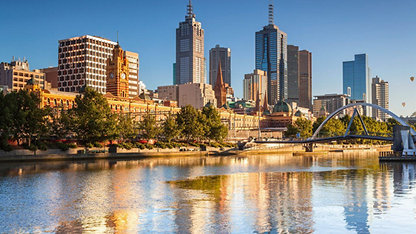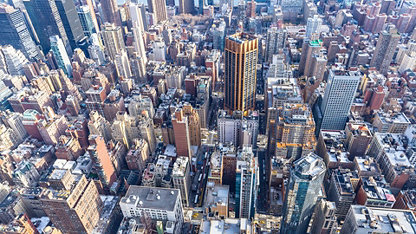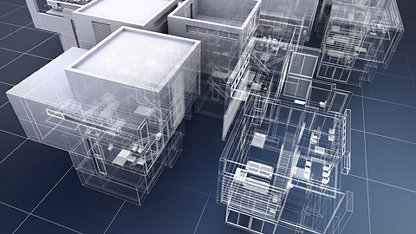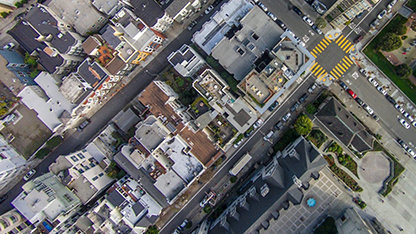As emerging technologies converge with urban planning, a revolution of automated, on-demand and ownerless transport beckons. But is the concept of an intelligent city network a deliverable reality, or just sci-fi fantasy?
The recent return of Blade Runner to cinemas provides us with a timely reminder of the world created in the first film, set in the Los Angeles of 2019. In truth, director Ridley Scott’s original vision is now some distance from the aspirations of today’s city planners.
An emerging world of smart cities – the convergence between technology and urban planning – is already opening up massive opportunities to rethink the way that we live, work and play. But the film’s predictions for flying cars, synthetic human-like robots, space colonisation and artificial intelligence have turned out to be – for the most part – wide of the mark.
“Blade Runner did, if nothing else, correctly anticipate today’s world of rapid urbanisation, rising population, climate change and the birth of the technology-supported smart city.”
Yet, according to Siemens senior vice president Steffen Endler, Blade Runner did, if nothing else, correctly anticipate today’s world of rapid urbanisation, rising population, climate change and the birth of the technology-supported smart city. The way we live our lives is unavoidably set for disruption. “Creating the liveable city takes four components to make it happen effectively,” explains Endler, who heads Siemens’ Digitalization Hub in Singapore. “It takes thoughtful designs and plans, political will and societal support, technology that is fit for purpose, and good governance and collaboration to sustain the plan.”
And the glue that holds this smart vision together is the transport networks that enable the new landscape to be traversed. We are, Endler points out, already on this development journey, beyond a so-called Infrastructure 1.0 of dumb brick and steel, and moving through the semi-automated Infrastructure 2.0. Ahead of us lies the intelligent Infrastructure 3.0 of driverless trains, fully automated buildings and smart grids managing loads, storage and generation, before we reach Infrastructure 4.0 – the fully integrated, intelligent and adaptive smart city infrastructure that is able to provide demand-responsive city services and incident management.
It is, without question, a very attractive prospect, and one that is already exciting city leaders, infrastructure designers and transport planners. The question is: can it be delivered, or are we simply heading off towards a new Hollywood fantasy?
“Look at the world around us and you will already see the evidence of the smart transport network in action: paperless e-ticketing on transport systems, sensors built into highways, driver assistance systems in cars, intelligent traffic lights and traffic management systems, and train automation,” explains Endler. “Our road transport will inevitably follow the same pattern of technical progress of all past machines: we motorise, we electrify and we automate.”
Being able to construct a smart city from the ground up is a rare privilege but one that Qatar is already embracing with its $45bn Lusail City. Work started on the 38 km2 city in 2008, in preparation for the 2022 FIFA World Cup for which Qatar is – somewhat controversially – the host. It is the largest development ever planned in Qatar and a key real estate plank in the National Vision 2030, which sets out to invest in and strengthen the national economy, but also to balance growth with environmental protection and sustainable development.
As such, developer Qatari Diar has set out stringent international design standards and embarked on a programme of detailed planning that it hopes will ensure that Lusail embraces the latest smart city technologies and builds in the flexibility to accommodate future innovations.
Once it is completed in 2020, Lusail is expected to be home to 200,000 residents, with another 170,000 workers travelling in each day. Its 19 city districts will include residential, commercial and entertainment sectors, schools, mosques and medical facilities. Two Foster & Partners-designed towers will act as landmarks in the new financial district.
A comprehensive transport network underpins its ambitious smart city plans in a way that is only really possible when you plan, design and construct a city from new, according to Eugene Seah MRICS, senior director, special projects, in the Group CEO Office of Surbana Jurong, the Singapore government’s infrastructure consultant. “Lusail is an example of a project starting in the right direction and with effective investment into the smart city,” he explains. “The project planners have looked at the end state and then started planning from the onset of the project.”
At the heart of Lusail’s transport system is a low-energy, light-rail transit network connecting the city’s districts with four underground and overground lines, 36 stations and 38.5 km of track. Eventually, this will link up to future intercity rail services.
But it is not all about trains. Cars will still be a significant element in the transport system, so interconnected underground car parks will support a carefully planned road system designed to limit congestion in the city. A devoted bicycle and pedestrian network, with water taxis taking advantage of a canal network, will also relieve pressure on the road- and rail-based public transport.
Seah points to other global cities, particularly in the rapidly developing regions of Asia such as Singapore, Hong Kong and Shanghai, which have been leading the charge when it comes to developing smart cities and transport networks, using technologies such as the internet of things (IoT), sensors and data analytics. “Getting these correct would mean better systems for maintainability and predictability for instance, moving large quantities of people, safely, efficiently and conveniently,” he says. “The ultimate aim is to improve the commuters’ quality of life.”
“The rise of on-demand, individualised services such as Netflix, Apple music and Airbnb have demonstrated the power of customer-focused business models, and this is now rapidly transferring to the transportation space.”
Amy Child
Arup
Having spent much of the last two years travelling around the developed and developing world, RICS past-president and CBRE partner Amanda Clack FRICS agrees that projects such as Lusail City are accelerating the development of smart city transport networks. “The great thing with experimental or new cities like Lusail is that they can develop from a blank canvas and, as such, help develop and push on technologies and concepts covered elsewhere,” she says. “Lusail is fascinating, as much of the initial seven years of development was focused on installing the subterranean infrastructure to service the future city above ground. This has created a range of plug-and-play development opportunities that push the city to a different level.”
And, she adds, while they may seem like expensive, one-off exercises, projects such as Lusail are vital to push the boundaries of what is possible. Other cities also now leading the way include Shenzhen and Tianjin in China, Songdo in South Korea, Brasilia in Brazil, plus Singapore, Hong Kong and Dubai.
“We need these examples to help bring new thinking to developed or developing cities around the world,” says Clack. “The way people use transport is likely to become more on demand, with less reliance on car or personal transport ownership. This will place increased pressure on public and private services to meet this demand on time, and to provide data and data networks to help people make informed decisions on transport modes in the moment. People are requiring more personal data networks that can travel with them to provide an immediacy of information on the go.”
Amy Child, associate transport and urban planner with Arup in Melbourne, agrees that creating smart networks is very much about engaging with people and, critically, embracing the ways that we are all now living our lives. “Digital technology and the ubiquitous smartphone means that we are now all very much geared around the user experience across all sectors and services,” explains Child. “The rise of on-demand, individualised services such as Netflix, Apple music and Airbnb have demonstrated the power of customer-focused business models, and this is now rapidly transferring to the transportation space.”
Personalisation of transport means a future beyond simply providing static infrastructure. Customers now want a personalised service whether they are using public or individual personal transport. That means the traditional mass transit business models such as heavy rail, based on big infrastructure investment and governed by timetables and levels of services are no longer the only solution in town. On-demand, digitally enabled transport systems, which can be more agile and responsive to meet customer need, will fill the gaps where demand exceeds supply, or where no supply currently exists.
Singapore’s Beeline bus service is a great example of this new wave of thinking. The crowd-sourced private bus service was set up in 2015 and now has 130 routes run by seven private bus operators, with 19,000 active monthly bookings. The concept is simple – the public suggests a route, Beeline analyses the crowd-sourced data to identify whether the route is viable and, if so, asks private operators to bid to run it.
Such services are part of the new sharing economy which, according to PwC, was thought to be worth $15bn a year at the time its report, The Sharing Economy, was published in 2015, but could rise to £335bn by 2025. And transport could potentially be the biggest sector of this market.
Swedish automotive start-up Unity will this month launch its prototype for a new purpose-built lightweight electric vehicle designed specifically to integrate with this emerging digital-platform-based economy, either driver controlled or autonomously. But the sky is literally the limit for transport options backed by such platforms. Dubai’s Roads and Transportation Agency, for example, is pressing ahead with plans for an autonomous passenger drone network, while Israeli firm Urban Aeronautics says its military-designed passenger drone could be in civilian use by 2020.
Back in the present, ride-hailing app Uber now operates in more than 600 cities around the world, and bike-sharing schemes are being taken to the next level by “dockless” operators such as Mobike and Ofo, which have embarked on aggressive expansion campaigns beyond their Asian bases.
Despite this personal transport revolution, smarter and more efficient mass public transport solutions will remain core to serving ever-growing city populations, says Alistair Gollop, technology services engineering lead at Mott MacDonald in Southampton. “The need for efficient transport modes will inevitably result in the requirement for mass public transport to offer a reliable and comfortable means to travel,” he explains. “There simply will not be the capacity to handle the huge daily commuter influx that our cities need to cope with, by using individual vehicles for each person.”
However, he adds: “Supporting that tidal flow of workers will also require a mix of transport modes to get people to the transit hubs, and for shopping, school and leisure trips. Although the use of privately owned vehicles is bound to continue for some time, alternative mixes of sustainable modes such as walking and cycling will increase.”
This mix, says Gollop, will include the emergence of Mobility as a Service – or Maas for short. It is a key phrase that will soon permeate our lives in the way that smartphones have over the last decade. Essentially, it is the integration of transport – a single monthly charge to cover and plan all your travel needs across trains, buses, trams, taxis, bikes and hire cars without the need to buy or book a ticket.
Already operating in Helsinki, pioneering Finnish operator Maas Global is now rolling out its Whim app and services in the UK across the West Midlands. Its goal is to make it unnecessary for any city resident to own a private car by 2025.
Without question, technology will create significant change to the way that smart cities of the future are planned and built, with improved capacity freeing up land for public transit, walking, cycling and housing. City transport will become cleaner, more rapid and also more autonomous – with many even predicting that development of this technology means the next generation of children will have no requirement to even take a driving test.
“The reality of hyperloop, drones, fewer cars on our streets and electric vehicles will become the norm,” explains Clack. “We need cities such as Lusail to push the boundaries.” On this basis, Blade Runner’s dystopian city vision looks even less likely as a reality.















